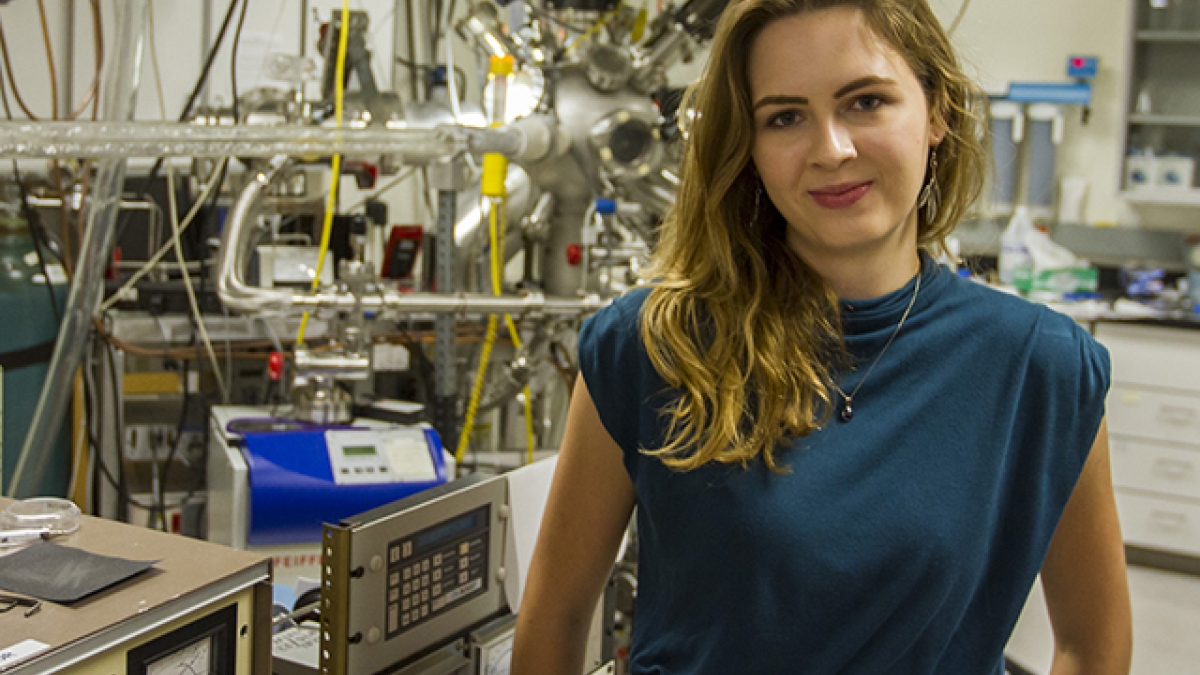ASU freshman to attend Nobel Prize ceremonies

ASU freshman Sarah Galvin’s promising path to a life of science began in kindergarten.
“Someone told me that scientists get to blow things up. So I knew exactly what I wanted to be," she says.
In high school, she excelled in chemistry, and every other subject, and didn’t want to wait until college to start putting her interests in science into action.
She began looking into research opportunities open to high school students through Arizona State University's Southwest Center for Education and the Natural Environment (SCENE), and became intrigued by the description of work led by Nathan Newman, a professor in the School for Engineering of Matter, Transport and Energy, one of ASU’s Ira A. Fulton Schools of Engineering.
One of Newman’s projects involved his lab team’s efforts to help make the technological breakthroughs necessary to develop next-generation electronics. It involved applying quantum mechanics, manipulating electrons and combining existing materials and creating new ones to make new energy devices, and something called spintronics – short for spin transport electronics – all of which attracted Galvin.
For two years, as she finished high school, Galvin spent what time she could in Newman’s lab. She experimented with combining various materials to fashion small structures called tunnel junctions that are capable of using magnetism rather than an electrical current to power devices – a method promising to enable development of electronic devices that would be more compact and energy efficient, and would operate more rapidly.
The technology promises not only higher-performing consumer electronics, Newman said, but also new devices that could significantly improve the energy efficiency of the kind of advanced supercomputers used by the likes of Google, Yahoo and the National Security Agency.
Award-winning research
Galvin's work in Newman's lab earned her a first-place prize at the Intel International Science and Engineering Fair, where she competed against 1,700 of the top high school students from 70 countries around the world – all before graduating from Corona del Sol High School last spring.
Her prize brought with it two scholarships totaling $8,000 and a ticket to the prestigious Nobel Prize ceremonies in Stockholm – a perk of the Dudley R. Herschbach Award, which enables Galvin to join some of the world’s most promising young science students this December at the Stockholm International Youth Science Seminar in Sweden.
Galvin's Intel entry was also selected as the best project in computer engineering, earning her the K. Soumyanath Memorial Award, which provides a $3,000 scholarship. Additionally, the same project won her a Future Innovators of the Year Award, one of the annual Arizona Governor’s Celebration of Innovation awards to be presented next month.
Her work in Newman’s lab became the basis for the project she entered in the Intel Fair (called “An Innovative Approach to Improve Spin Polarization in Co2FeAl0.5Si0.5 Thin Films for Spin Transport Electronics”), and her success has helped to secure a position as an undergraduate research associate in Newman’s lab, giving her the opportunity to continue pursuing advances in spintronics.
Leadership in the lab
For the immediate future, Galvin's research will be concentrated on producing inexpensive, large-area photovoltaic technology that can be used on building exteriors to generate solar energy, Newman said.
He has little doubt that she will make progress in the effort.
“Most younger students will typically do a small part of the work on projects like this, and then turn things over to an experienced graduate student,” Newman said. “But with some guidance, Sarah has handled most of it herself, including the physics, the engineering and the application of scientific method.”
Galvin has shared authorship credits with Newman and other members of his research team on a paper published in the prominent research journal Applied Physics Letters, a publication of the American Physics Institute.
Her work with Newman’s lab drove Galvin’s decision to major in electrical engineering, a degree program in the School of Electrical, Computer and Energy Engineering.
“I decided on engineering because I like being able to physically do things and create something,” she said. “I like the mechanics of it, as opposed to some areas of science where you mostly observe and study things. In engineering I can see where I might be able to do something that makes a difference, and so much is happening in electrical engineering right now.”
See Galvin and Newman discuss their research on the show "Horizon." Galvin's story was also featured by Channel 12 News in Phoenix.